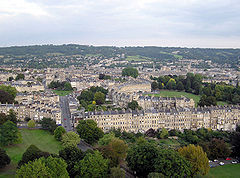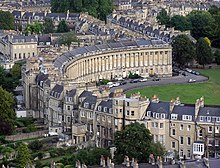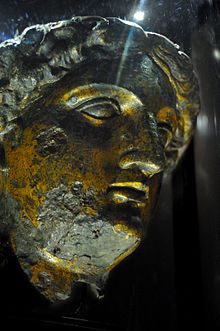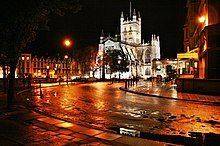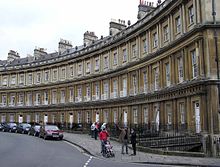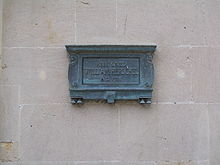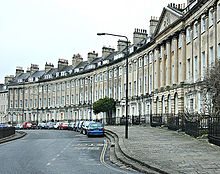Bath
| City of Bath | ||
|---|---|---|
| Aerial view of Bath | ||
| Coordinates | 51 ° 23 ′ N , 2 ° 22 ′ W | |
|
|
||
| Residents | 86,000 | |
| surface | 29 km² (11.2 mi² ) | |
| Population density: | 2966 inhabitants per km² | |
| administration | ||
| Post town | BATH | |
| ZIP code section | BA1, BA2 | |
| prefix | 01225 | |
| Part of the country | England | |
| region | South West England | |
| Ceremonial county | Somerset | |
| Unitary authority | Bath and North East Somerset | |
| British Parliament | Bath (constituency) | |
| Website: http://www.mayorofbath.co.uk/ | ||
Bath [ bɑːθ ] is a town in the west of England in the county of Somerset on the River Avon , about 20 km from the larger city of Bristol . It is famous for its Roman baths, which were developed from warm springs by the Romans who lived here from AD 43 . According to tradition, these only hot springs in England were known in pre-Roman times. Since the time of Elizabeth I , Bath has increasingly developed into a health resort for the wealthy population. As a result, there are still many historical buildings, especially those from the Georgian era, in the city. The stone that defines the cityscape is the Bath Stone, which was quarried in the neighborhood .
One of the most famous buildings from this period is the Royal Crescent . Bath is classified as a World Heritage Site by UNESCO . In 2001, almost 170,000 people lived in the administrative district of Bath and North East Somerset , and in the city itself around 86,000 people, who call themselves Bathonians . With the University of Bath and Bath Spa University, Bath is a university city.
geography
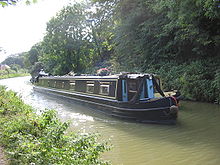
Bath is about 25 kilometers southeast of the large port city of Bristol , with which it is connected by the A4 national road. The M4 motorway is at the same distance to the north. The urban area extends over an area of 29 km². Bath Spa Central Station is operated by First Great Western and is on the main route between Bristol and London . The Cardiff – Portsmouth route also runs through the city.
The River Avon flowing through Bath connects the city with Bristol and with the sea. The river is navigable through locks and can be navigated with narrowboats . There is also a waterway that connects the city to the Thames and London, the Kennet and Avon Canal . The canal was closed for many years, but was restored towards the end of the last century and can now be sailed again with narrowboats, which have become a tourist attraction. In earlier years the canal was an important waterway to London. The Avon often caused floods in the city area in earlier years. Flood protection measures in the 1970s finally helped.
Bath is at the southern end of the Cotswolds in the River Avon Valley. The Cotswolds are known as a range of hills of scenic beauty. The hills surrounding the city are 238 m high at the highest point, the Landsdown Plateau. These hills, which surround the entire city, also make for the steep streets and the visual impression that the houses are practically climbing up the hill.
climate
The climate in Bath is temperate, although significantly warmer than other places at the same latitude . This is attributed to the warming influence of the Gulf Stream . The prevailing wind comes from the southwest of the North Atlantic. Half of the year the sky is overcast. Especially in winter there are occasional storms and floods. In 2003 the average temperature was 10.3 ° C. There were 1645 hours of sunshine and 957 mm of rain. This means that these values are higher than the British average (9.5 ° C / 1587 hours of sunshine / 901 mm of rain)
politics
Bath used to be part of Somerset but became part of Avon when that county was founded in 1974. Since 1996 it has been the center of the new county of Bath and North East Somerset . Liberal Democrat Don Foster is a Member of Parliament for Bath. His 1992 election was perhaps one of the most notable of the parliamentary elections of the time, as Chris Patten , the previous MP - minister and chairman of the Conservative Party - played a major role in Prime Minister John Major's nationwide campaign but was unable to to win his own constituency in Bath. Foster has been re-elected every time since then.
City coat of arms
The coat of arms contains two silver stripes that are supposed to represent the Avon River and the hot springs. The sword of St. Paul is a reference to Bath Abbey . The two animal figures on the side of the coat of arms stand on branches, a reference to Bladud , the legend of Bath. The knight's helmet stands for city rights and the crown is that of King Edgar , the first king of united England, who was crowned in 973 on the site of the current abbey. The writing "Aquae Sulis" gives the city's Roman name.
history
The city owes its foundation to its thermal springs . The main source was already known to the Celts , who had dedicated it to the goddess Sulis . After the Romans had conquered the British island in 43, they soon became interested in this place and began to build a place with bathing facilities based on the Roman model ( thermal baths ). They called the place Aquae Sulis (dt. The waters of the Sulis), but interpreted Sulis as Minerva .
There is evidence from the years 300-350 that suggests that Christians lived in Bath. At the time of the end of the Roman occupation of Britain in the 5th century, Bath was conquered by the Anglo-Saxons at the Battle of Deorham in 577 . They gave him the name Hat Batha , engl. Hot Baths "hot baths", from which the current name goes back. With the departure of the Romans and the dwindling influence of the Roman Empire, the decline of bathing culture and baths began, also in Bath. They literally sank in the mud and were only accidentally rediscovered in the 19th century. After a convent for Christian nuns was founded in Bath around 676, King Cynewulf of Wessex gave the monks of St. Peter of Bath a piece of land around 755, on which they founded the monastery of St. Peter near the Roman remains, which later became the Benedictine order belonged. Dominion over the monastery of St. Peter at Bath was won in 781 by Offa de Mercien . Edgar is the first King of England to be crowned in Bath Abbey in 973 .
In 1066 it was conquered by the Normans at the Battle of Hastings . John of Tours becomes Bishop of Bath, installed by William II. He had a Norman cathedral built in place of the abbey , as well as three large baths: the King's Bath , the Cross Bath and the Hot Bath . The baths were under the control of the bishop and soon gained a reputation throughout England for healing. In 1180 a hospital was founded under the direction of the monastery. In the Middle Ages, however, Bath developed primarily into a center for cloth weaving. Under Henry IV , the city then fell into disrepair again, including the baths and the cathedral, which in 1499 lay in ruins. In the course of time the monastery at Bath was closed in 1539 and the crumbling abbey was handed over to the city in 1569. Only after a visit from Queen Elizabeth I in 1574 did a new upswing begin, which was connected with the growing popularity of medicinal water . It was the time of extensive spa treatments, and Bath now had five large spring-fed baths. Bath received city rights in 1590 . In the 16th and 17th centuries, nobles and even monarchs came here for cure and made the place known. The English queen was a guest in 1702. The steep rise as a world-renowned health spa began. By 1800 the population had grown to 34,000 thanks to the cure; Bath was the eighth largest city in England. The development of the city was strongly influenced at the beginning of the 18th century by Richard "Beau" Nash (1674–1761), who bore the honorary title of "King of Bath". He tried to create a glamorous image for the spa, provided an extensive range of entertainment during the season and influenced the town planning. Another person, postmaster Ralph Allen , who came from a humble background, played a decisive role in Bath's development as the quarry owner. He supplied the Bath Stone from his quarries, making him one of the richest men in England. From 1735 to 1748 he had his country residence Prior Park built on a hill southeast of the city , which was not only a symbol of his wealth, but also of the quality of his stones.
In the 19th century, however, Bath was overtaken by other European spas in its importance as a health resort, and the heyday was over. However, in 1889 the King's and Queen's Bath were restored and rebuilt, and in the course of this construction work was found on the old Roman bath, which was largely preserved.
In April 1942, Bath was bombed by the German Air Force during World War II. Over 19,000 houses were damaged and 329 destroyed in the attacks, killing around 400 people. Bath has had a partnership with the Lower Saxony city of Braunschweig since 1971 .
Bath has been a UNESCO World Heritage Site since 1987 . In 2005, the large bath complex Thermae Bath Spa with several baths as well as a wellness and beauty area was opened as a new attraction .
18th century architecture
Up until the beginning of the 18th century, around 3,000 people lived within the city walls. In just a century, the population of Britain's most important thermal baths grew more than tenfold to 34,000. The architect John Wood the Elder and his son John Wood the Younger designed a spacious cityscape that blew up the medieval city walls and did not follow a rigid geometric scheme.
A sequence of squares and connecting streets in Bath are arranged in such a way that new views open up again and again. John Wood the Elder began with the square Queen Square in 1729 , followed by the monumental layout of the circular circus with three converging streets in 1754 . The son John Wood (1728–1781) continued his father's work without a break. 1767–1775 the Royal Crescent was built , a semicircular square that opens onto an English garden. The architectural design of the house facades contrasts with the dynamic floor plan of the urban expansion. The colossal order of 114 Ionic half-columns and pilasters above a basement, behind which there are 30 terraced houses , is almost always drawn around the square without any accentuation or rhythm.
The spa stay in Bath was determined almost exclusively by social life and less by medical aspects. The thermal baths of the 18th century are correspondingly modest, which, like the Hot Bath from 1775, are characterized by a refined floor plan, but above all by modest dimensions. That the drinking cure a greater importance was attached, shows the Great Pump Room , 1786-1796 by Thomas Baldwin and John Palmer as representative pump room built.
The typical facilities of Bath are partly borrowed from the metropolises and made the health resort the focal point of a new leisure time. The new forms of social life combined with promenades, ballrooms, concert halls, theaters and coffee houses. Many visitors came only for a long weekend, which promoted the expansion of the traffic routes, especially to London .
The urban structures of the Palladian architecture in Bath are particularly striking . The adoption of symbols of aristocratic architecture by the rising bourgeoisie is also typical.
Friedrich Wilhelm Herschel in Bath
From 1766 to 1782 the German composer, musician and astronomer Friedrich Wilhelm Herschel worked as organist at the Oktogon Chapel in Bath. He enriched concert life with numerous concerts, at which his own compositions were often played. From 1772 Herschel began to be more and more interested in astronomy . When the conventional instruments were no longer sufficient for him, he built mirror telescopes himself, which he achieved with considerable skill. He even poured and polished the (metal) mirrors himself.
On March 13, 1781, Herschel discovered the planet Uranus with a self-made telescope in the garden of his house at 19 New King Street in Bath . This was the first planetary discovery since ancient times. In Herschel's time it was actually thought that there was nothing left to discover in the sky. Accordingly, the discovery of the new planet was a scientific sensation that made the amateur astronomer Herschel known all over Europe at one stroke. In 1782, Herschel accepted an offer from King George III of England . to become his court astronomer. Although the offer was not financially very attractive to Herschel, Herschel accepted it, seeing the opportunity to devote himself entirely to astronomy from now on.
Later on, Herschel went to Bath a few more times for spa stays.
Attractions
- The Roman baths
- The Bath Abbey
- The Jane Austen Center
- The Fashion Museum , formerly the Museum of Costume
- The Building of Bath Museum (architecture)
- Royal Crescent No. 1 (building)
- The Herschel Museum
- The Museum of Bath at Work (industrialization)
- The Bath Postal Museum (postal system)
- The American Museum in Britain
- Thermae Bath Spa (bath complex)
- The Circus
- Pulteney Bridge , an 18th century bridge
Parks
The city has several public parks, the largest being the Royal Victoria Park , just a few steps from the center of the city. It was opened in 1830 and extends over 150,000 m². Various events take place in the park every year. The international music festival deserves special mention. The park is also popular as a launch site for hot air balloon rides. There you will find a botanical garden, a large children's playground and sports facilities. Directly adjacent is the famous Royal Crescent , which from a certain angle looks like part of the park.
Other parks in Bath include: Alexandra Park, on a hill above the city; Parade Gardens, on the riverside near Bath Abbey not far from the center; Sydney Gardens , known as the pleasure garden in the 18th century; Henrietta Park; Hedgemead Park; and Alice Park. Jane Austen wrote of Sydney Gardens that “it would be nice to be in Sydney Gardens. We could go to the labyrinth every day. ”Alexandra, Alice and Henrietta Parks were built as green spaces directly into the settlements.
traffic
Bath Spa Station is at the junction of the Great Western Main Line and Wessex Main Line . It is served by trains from the Great Western Railway , CrossCountry and South Western Railway companies.
Sports
Bath is a stronghold of rugby union . In the stadium Recreation Ground playing Bath Rugby , a team of top English league and six-time English champion. This stadium is also used for cricket matches. In Twerton Park is home to the football club Bath City .
Twin cities
Bath has partnered with the following cities :
|
|
sons and daughters of the town
- Adelard von Bath (≈ 1070–1160), important scholar of the 12th century
- Margaret Pole, 8th Countess of Salisbury (1473–1541), next to Anne Boleyn, the only woman in England in the 16th century to have an earl dignity in her own right
- Thomas Chilcot (≈1707–1766), composer and organist
- Sarah Fielding (1710–1768), writer and translator
- Ann Street Barry (1733–1801), singer, dancer and actress
- Richard Lovell Edgeworth (1744–1817), enlightener and inventor
- Aylmer Bourke Lambert (1761-1842), botanist
- William Edward Parry (1790–1855), admiral and polar explorer
- Lucy Anderson (1797-1878), pianist
- James Brooke (1803–1868), adventurer
- Richard Guyon (1803-1856), a 19th century general
- Charles Spackman Barker (1804–1879), organ builder
- Thomas Jones Barker (1815-1882), painter
- Edward Millard (1822–1906), director of the Austrian Bible Society and pioneer of the Baptists in Austria
- Hodgson Pratt (1824-1907), pacifist
- George Augustus Graham (1833–1909), officer and cynologist
- Charles John Phipps (1835–1897), theater architect
- Arthur Garner (1851 - after 1898), Australian actor and theater entrepreneur
- Percy Pilcher (1866–1899), inventor and a pioneer of aviation
- Edith Garrud (1872–1971), suffragette, Jiu-Jitsu teacher and author
- Alan Bullock (1914-2004), historian
- Raymond Carr (1919-2015), historian
- Peter Wason (1924-2003), psychologist
- Philip Jones (1928–2000), trumpeter and founder of the Philip Jones Brass Ensemble named after him
- Jonathan Lynn (* 1943), film director, screenwriter and actor
- Michael Spicer, Baron Spicer Kt (1943–2019), journalist, spy novelist and politician
- Linda Partridge (born 1950), geneticist
- Mike Mower (* 1958), jazz musician
- Curt Smith (born 1961), musician
- Jeremy Guscott (born 1965), rugby player
- Michaela Tabb (* 1967), multiple world and European champion in pool, snook referee
- Jason Dodd (* 1970), soccer coach and player
- Peter Salisbury (* 1971), musician
- Indira Varma (* 1973), actress
- Claire Louise Coombs (* 1974), Princess of Belgium
- Jason Gardener (born 1975), track and field athlete
- Melanie Gabriel (* 1976), singer-songwriter
- Jamie Cullum (born 1979), musician
- Gabby Young (* 1984), singer-songwriter, guitarist and band leader
- Ashley Barnes (born 1989), soccer player
- Scott Sinclair (born 1989), soccer player
- Charlie McDonnell (* 1990), video blogger and musician
- Gabrielle Aplin (* 1992), singer-songwriter
- Angelica Mandy (* 1992), actress
- Siobhan-Marie O'Connor (* 1995), swimmer
- Tom Gale (* 1998), athlete
- Xavier Amaechi (* 2001), football player
as well:
- Tears for Fears , music band
literature
- Iris Loosen-Frieling: Architecture between norm and taste. The architecture of the square by John Wood the Elder and John Wood the Younger in Bath (= Studies on Art History , Volume 68), Olms, Hildesheim et al. 1992, ISBN 3-487-09616-1 .
See also
Web links
Individual evidence
- ^ National Trust: Prior Park History. Retrieved March 14, 2013 .
- ↑ a b c d Wilfried Koch: Building Style - The standard work on European architecture from antiquity to the present . 32nd edition. Prestel Verlag, Munich 2014, ISBN 978-3-7913-4997-8 , pp. 371 .
- ↑ http://www.mayorofbath.co.uk/twinning-associations Bath official website
